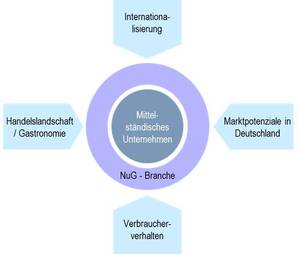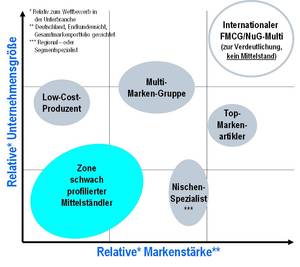Since the early nineties, unitcell's consultants have been intensively involved with the food industry and fast moving consumer goods (FMCG) in Germany and internationally.
The focus is often on medium-sized companies and groups of companies.
With our current "Position Paper on the Food Industry - Perspective on Medium-Sized Companies", we want to briefly and concisely summarize the central issues that have a lasting impact on medium-sized food companies in Germany in particular.
In doing so, it is important for us to take a strategic view of the companies in conjunction with identifying and discussing central operational and administrative fields of action at both the strategic and tactical levels.
To always keep this perspective in mind is elementary for entrepreneurs and managers, of course for consultants, but also for business partners of the medium-sized food industry in order to promote a good development of these companies. Assessments or recommendations for individual companies can only build on this.
Our position paper takes a detailed look at these issues, provides benchmarks as well as statements on individual sub-sectors such as meat processing, bakery products, dairy products and beverages.
Essential dynamics
From our point of view, four dynamics, which have an external impact on the food industry as a whole, essentially determine the perspective of medium-sized companies today.

These are
- the increasing internationalization,
- the long-term decline in market potential in Germany with varying regional characteristics,
- the changing strategies primarily of the institutionalized food retail trade (LEH) and
- the successively changing consumer behavior in conjunction with "day-to-day" economic and political events.
Central theses
These dynamics lead - in our view - to the following developments:
I. Shifts in purchasing power and distribution structures are having an impact above all on medium-sized companies with a regional sales focus.
Within Germany, there is a sustained trend toward shrinking regions with significant declines in demand and booming regions in which demand is expected to grow, contrary to the Germany-wide trend.
II. the real positive development of the German food industry is based exclusively on increasing exports (primarily to the EU). Supplying retailers in Germany who then export has a significant share in this.
This affects almost all sectors and will continue - also in order to compensate for the declining volume-based market potential and the increasing pressure on earnings in Germany.
III Food retailing is gradually strengthening its already dominant position. With increasing concentration and synchronization in food retailing, the transparency of, for example, manufacturers' sales prices and conditions to retailers or their performance is also increasing.
The threat to low-profile SMEs is increasing not only because of the transparency of conditions, but also because of the backward integration of retailers: on the one hand, they are acting as direct competitors, and on the other hand, they are gaining a better understanding of the manufacturers' calculation bases.
IV. Discounting sales channels have reached their zenith in Germany and have successively displaced supermarkets - especially the small ones. Growth is being recorded above all by large-area store concepts with a broad food and non-food assortment, whose shares in Europe are in many cases (still) larger than in Germany. On the other hand, further moderate growth of discounters can be expected in Europe. In many places, this will benefit both German and foreign manufacturers.
Supplying internationally operating German retailers therefore remains a growth opportunity for German companies, depending on the product group. Above all, however, the acquisition of international retail groups must be stepped up, which requires international key account sales structures and, depending on the product group, field organizations.
V. The often medium-sized, medium to weakly profiled manufacturer brands (middle brands) are coming under increasing pressure from the (initially discount-driven) further expansion of private labels and now, above all, the expansion of higher-value positioned (= value-added) private labels, which is gradually finding its way into all distribution channels of the food retail trade.
At the same time, private labels and value-added private labels offer sales and earnings opportunities for medium-sized companies that help to compensate for the loss of sales of their own brands. Further growth of private labels in Germany, but especially in Europe, is to be expected.
VI The premium brand segment, which is already dominated by FMCG/non-food multinationals, multi-brand groups and medium-sized top brand manufacturers, is holding its own in Germany.
VII Since the mid-2000s, rising world market prices have led to cost explosions for raw materials, consumables and supplies with significantly increased volatilities, especially for agricultural raw materials. Passing these price increases on to the consumer has worked in the past (at least with a time lag).
If the predictions regarding income development come true, this will put further pressure on the middle brands, as their clientele will be less able to bear the price increases and will therefore tend to increasingly turn to (value-added) private labels. The earnings situation in the main subsectors of the food industry is currently extremely weak.
VIII. The needs of the end consumer - beyond price, convenience and quality orientation - are becoming increasingly complex and will continue to grow. Today's product diversity allows him or her to take all life circumstances into account when choosing a product, which on the one hand is characterized by stable basic attitudes, but on the other hand is extremely situational.
Transparency, origin, sustainability and fairness are current trends here; variants and innovations a must for the product experience and for maintaining brand loyalty.
IX. In times of crisis, the products of the NuG sector are among the first to be affected. Here, the consumer saves directly. In some industries, strong seasonal effects also have a positive or negative impact on sales during the year (weather, constellation of holidays, etc.). Taken together, this can account for annual sales fluctuations of several percentage points for companies.
X. The degree of concentration in the industry and all sub-industries is high and will continue to rise - in some cases "hidden" by shareholdings.
Medium-sized suppliers are increasingly facing significantly larger, financially stronger, more cost-effective production or brand-strong competitors. Smaller companies are thus generally dependent on effective protection through market niches.
Strategy types in the food industry

Despite all the difficulties, a number of medium-sized companies have been able to position themselves strategically as low-cost producers, multi-brand groups, top brand manufacturers or niche producers.
Nevertheless, against the backdrop of the aforementioned developments, these companies are of course still obliged to master their "strategy-typical" challenges, such as more elaborate brand management, the pressure of internationalization , coping with complexity and integration, tapping synergies, creating transparency and control at top management level, or shaping and securing the niche in the long term.
In our experience, SMEs that have not achieved a strategic profile are particularly at risk from the destruction of their substance. After successive deteriorations in earnings and sales, phases of dramatic sales declines frequently occur.
The decisive factor is whether a change of course can still be initiated with the available resources and then the basis for a clear future positioning can be achieved.
Essential mandatory topics for all companies in the industry are e.g.
- active complexity management (not primarily reduction, but management and cost-optimized organization of complexity),
- working capital management,
- cooperation management (fixed/temporary, vertical/horizontal),
- overall risk management,
- forward-looking quality management,
- the "constant" adjustment of the marketing mix and
- meaningful (investment), corporate and divisional controlling at strategic, tactical and operational level
- on the basis of an integrated high-performance DP.
You will find the contents of the study and a small insight in this excerpt from our position paper.
You can purchase the comprehensive study for a nominal fee of 249,- Euro.
If this brief outline and the above linked excerpt of our nearly 100-page position paper on the food industry have piqued your interest for a deeper insight, please feel free to contact us.
For this or for further information please send us an email to: welcome [et] unitcell.de
Contact person: Mr. Thomas Brede und Mr. Hannes Krüger